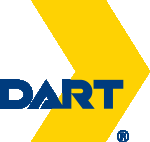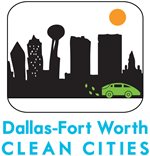DART introduces revised bus network
 Dallas Area Rapid Transit debuted its redesigned bus network in January, aiming to provide better connections to employment, education and entertainment across the DART service area.
Dallas Area Rapid Transit debuted its redesigned bus network in January, aiming to provide better connections to employment, education and entertainment across the DART service area.
The improvements rely on a combination of better frequency and coverage, more direct routes and later service to enhance connectivity throughout the network.
Core Frequent Network service will provide buses at 15-minute intervals during peak periods and every 20 minutes midday. Light rail service will also return to pre-pandemic levels, providing 15-minute peak service and more frequent evening service.
With the changes, 74% of people living in the service area are within walking distance of transit. Additionally, the changes allow passengers to reach their destinations more quickly, with a renewed focus on major corridors and fewer stops.
Transit riders working non-traditional hours also benefit from the change, as all local DART bus routes will provide daily service 7 days between 5 am and midnight, at a minimum. The 22 core frequent bus routes will operate between 4 am and 1 am. The new bus network also increases by 34% the number of jobs that a resident can reach in one hour.
Golink, DART's on-demand, curb-to-curb microtransit service also has been enhanced with the network redesign. Thirteen Golink zones have been added to replace traditional fixed-route service, bringing the total to 30. Weekend hours have been added to many Golink zones.
For the new schedules, visit www.dart.org/newbus. More about DART's new bus network is available at www.dartzoom.org.
UT opens study of transportation needs
The University of Texas at Austin has begun a research study to better understand Texans' travel needs and opinions in the face of the COVID-19 pandemic. Residents are invited to answer questions about their telecommuting, in-person work experiences and shopping and dining preferences, both before and during the pandemic.
The survey is open through March 15 and can be completed online.
Results of the study will be used to guide policy decisions and to design future transportation options.
This study was developed and is being conducted by The University of Texas at Austin, with support from the Texas Department of Transportation.
Panel to discuss automated vehicles virtually Feb. 24


The next virtual public meeting involving the Automated Vehicle 2.1 effort is scheduled for 6 pm February 24 and will feature a panel discussion on education and workforce development. Leaders in these fields will discuss what emerging transportation technologies mean for the rising workforce and the potential for new careers in North Texas.
Preparing for the rising workforce and the potential for new careers starts early and will require innovative and accessible resources for educators. Part of the discussion will highlight such resources, including a high school lesson plan created by the AV2.1 team. The lesson plan is specially designed to drive excitement and encourage students to consider their role in visioning the future of travel.

A key aspect of AV2.1, also called Connecting North Texas Communities with Emerging Transportation Technologies, is educating the public about the emerging transportation technologies that are coming to the region.
These include:
• Connected vehicles
• Automated vehicles
• Electric and shared vehicles
• High-speed rail and hyperloop
• Delivery robots and drones
• Air taxis
The discussion at the virtual public meeting will focus on challenges and opportunities related to preparing students for careers associated with these technologies. Register for the meeting here.
Connecting North Texas Communities with Emerging Transportation Technologies is the planning phase of NCTCOG’s AV2.0 program. The initiative will help community leaders plan for the future of transportation in North Texas by providing decisionmakers the data and tools needed to assess emerging transportation technologies entering the market and design the infrastructure needed to meet community needs.
This will be the second AV2.1 virtual public meeting. The first was held in in August 2021, when the initiative was launched, with a discussion of existing transportation needs in the region and an explanation of how the project’s results will help shape the future.
This second virtual public meeting will feature a greater emphasis on education and engagement with the region’s educators. For details on AV2.0 and how to participate in the planning for the emergence of automated vehicles, visit www.connectntxfutures.org.
High-speed rail chosen for further study in DFW
Dallas-Fort Worth High Speed Transportation Connections Study is expected to focus on advancing high-speed rail in the Interstate Highway 30 corridor into the environmental phase.
Following Phase I recommendations of the study, high-speed rail and hyperloop technology were identified for further study by the Regional Transportation Council last summer. NCTCOG and its federal partners have recently proposed a single technology move forward in the corridor so the National Environmental Policy Act (NEPA) process is not held up by the standardization of a developing technology.
The RTC will consider an updated policy endorsing this recommendation along with the pursuit of hyperloop technology for use in other corridors.
This could initially take the form of a facility allowing the demonstration or certification of the technology for future use in the region.
A separate high-speed rail line is also planned by Texas Central for the Dallas-to-Houston corridor, which would eventually be linked with the line connecting Dallas, Arlington and Fort Worth to form a system.
For more on the DFW High-Speed Transportation Connections Study, including how to participate, visit the project website.
Panther Island project awarded $403 million
The recently approved Infrastructure Improvement and Jobs Act includes $403 million for the Trinity River flood control project, also known as Panther island.
Rep. Kay Granger, R-Fort Worth, announced last month that the US Army Corps of Engineers released a work plan with the funding for this long-planned project, expected to cost a total of $1.2 billion.
The funding provided by the infrastructure bill will allow the US Army Corps of Engineers to complete the design of the project and construction of the 1.5-mile bypass channel, according to a press release issued by Granger’s office.
The project included the construction of three bridges over the planned channel at a cost of $127.4 million, with the Regional Transportation Council committing $32 million.
The White Settlement, Main Street and Henderson Street bridges have all been completed, with the latter having been dedicated last fall.
DFW Clean Cities surveys due Feb. 18
 The Dallas-Fort Worth Clean Cities Coalition works with local fleets to promote strategies to reduce energy impacts and increase fleet efficiency, which saves money and improves air quality.
The Dallas-Fort Worth Clean Cities Coalition works with local fleets to promote strategies to reduce energy impacts and increase fleet efficiency, which saves money and improves air quality.
In 2020, DFW Clean Cities reduced the equivalent of approximately 24 million gallons of gasoline across 55 fleets using over 10,000 alternative fuel vehicles and equipment.
This data is compiled in the Clean Cities annual report and provided by local fleets through participation in the annual survey, which can be completed at www.dfwcleancities.org/annualreport.
The region’s fleets are encouraged to complete the annual survey by February 18 to provide Clean Cities data on how the region is progressing toward its goals to reduce fuel consumption by more than 16% and greenhouse gas emissions by 20% each year. By participating in the annual survey, fleets can show their commitment to improving air quality. By providing this data to Clean Cities and adopting the Clean Fleet Policy, they are also eligible for the coalition’s Fleet Recognition Awards.
NCTCOG to host hybrid public meeting Feb. 7
NCTCOG will host a hybrid public meeting to provide an update on the region’s long-range transportation plan, an effort to develop a unified brand for a bicycle-pedestrian trail that will connect Fort Worth and Dallas, and other planning initiatives.
The meeting will take place at NCTCOG’s Arlington offices, 616 Six Flags Drive, at noon on Monday, February 7 and will also be streamed live at www.nctcog.org/input. A recording of the meeting will be posted afterward. Those attending in person are encouraged to wear masks and practice social distancing.
A primary responsibility of a Metropolitan Planning Organization is the development and maintenance of a Metropolitan Transportation Plan. This plan identifies how the metropolitan area will manage and operate a multimodal transportation system to meet the region’s goals. NCTCOG staff is developing an update to the current MTP, Mobility 2045, and will provide an overview.
Staff will present information on the Fort Worth to Dallas Regional Trail Branding and Wayfinding Project, which will create unified branding and signage for the Fort Worth to Dallas Regional Trail, which runs through Fort Worth, Arlington, Grand Prairie, Irving and Dallas. This project will build a regional consensus for ongoing marketing and operations for the trail and provide recommendations for support infrastructure.
Staff will present updates to the Title VI Program and the Language Assistance Plan. The Title VI Program documents how NCTCOG considers civil rights in planning. The program includes procedures individuals can use to file a complaint of discrimination. A 45-day public comment period will begin after the presentation.
Finally, NCTCOG is the host organization for Dallas-Fort Worth Clean Cities (DFWCC), a US Department of Energy initiative to reduce total energy impacts in the transportation sector. As part of these efforts, DFW Clean Cities surveys local fleets each year about alternative fuel use and other fuel-saving activities.
The 2021 annual survey now open and details on the survey goals and Fleet Recognition Program will be provided.
Imagery provided by DCTA, Getty Images and NCTCOG staff.